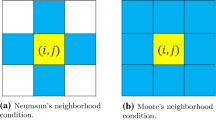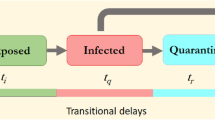Abstract
Developments in the information ages coming. The prevalence of covid-19 destroys economic and social development. This paper uses the data of COVID-19 epidemic in China from January 11, 2020 to February 9th to observe the trend of the number of confirmed cases and analyze the spatiotemporal distribution characteristics of the patients. On this basis, we establish the CA model and focus on the influence of different population activities on the transmission of infectious diseases by changing the parameters. Finally, it is concluded that inter provincial migration does have a certain impact on the spread of the epidemic, but its impact capacity is related to the geographical location of the target province; for individuals, the stronger the activity capacity is, the faster it spreads.
Access this chapter
Tax calculation will be finalised at checkout
Purchases are for personal use only
Similar content being viewed by others
References
Li, Q., Guan, X., Wu, P., Wang, X., Zhou, L., Tong, Y., et al. . Early transmission dynamics in Wuhan, China, of novel coronavirus–infected pneumonia. N. Engl. J. Med. 382(13) (2020)
Sirakoulis, G.Ch., Karafyllidis, I., Thanailakis, A., et al.: A cellular automaton model for the effects of population movement and vaccination on epidemic propagation. Ecol. Model. 133, 209–223 (2000)
Tindale, L.C., et al.: Transmission interval estimates suggest pre-symptomatic spread of COVID-19 (2020)
Wen, T.-H., Lin, M.-H., Fang, C.-T.: Population movement and vector-borne disease transmission: differentiating spatial-temporal diffusion patterns of commuting and noncommuting Dengue cases. Ann. Assoc. Am. Geogr. 102(5), 1026–1037 (2012)
Rajarethinam, J., et al.: Using human movement data to identify potential areas of Zika transmission: case study of the largest Zika cluster in Singapore. Int. J. Environ. Res. Public Health 16, 808 (2019)
Calvetti, D., Hoover, A.P., Rose, J., Somersalo, E.: Metapopulation network models for understanding, predicting, and managing the coronavirus disease COVID-19. Front. Phys. (2020)
Calvetti, D., Hoover, A., Rose, J., Somersalo, E.: Bayesian dynamical estimation of the parameters of an SE(A)IR COVID-19 spread model. arXiv preprint arXiv:2005.04365 (2020)
Shaman, J.: An estimation of undetected COVID cases. Nature 590, 38–39 (2020). https://doi.org/10.1038/d41586-020-03513-9
He, X., et al.: Temporal dynamics in viral shedding and transmissibility of COVID-19. Nat. Med. 26, 672–675 (2020)
Falcon-Lezama, J.A., Martinez-Vega, R.A., Kuri-Morales, P.A., Ramos-Castaneda, J., Adams, B.: Day-to-day population movement and the management of dengue epidemics. Soc. Math. Biol. 78, 2011–2033 (2016). https://doi.org/10.1007/s11538-016-0209-6
Zhang, P., Atkinson, P.M.: Modelling the effect of urbanization on the transmission of an infectious disease. Math. Biosci. 211, 166–185 (2008)
Author information
Authors and Affiliations
Editor information
Editors and Affiliations
Rights and permissions
Copyright information
© 2022 The Author(s), under exclusive license to Springer Nature Switzerland AG
About this paper
Cite this paper
Zhang, C. (2022). The Analysis of COVID-19 Propagation Process Based on Population Flow and Cellular Automaton Model. In: Xu, Z., Alrabaee, S., Loyola-González, O., Zhang, X., Cahyani, N.D.W., Ab Rahman, N.H. (eds) Cyber Security Intelligence and Analytics. CSIA 2022. Lecture Notes on Data Engineering and Communications Technologies, vol 123. Springer, Cham. https://doi.org/10.1007/978-3-030-96908-0_113
Download citation
DOI: https://doi.org/10.1007/978-3-030-96908-0_113
Published:
Publisher Name: Springer, Cham
Print ISBN: 978-3-030-96907-3
Online ISBN: 978-3-030-96908-0
eBook Packages: Intelligent Technologies and RoboticsIntelligent Technologies and Robotics (R0)




